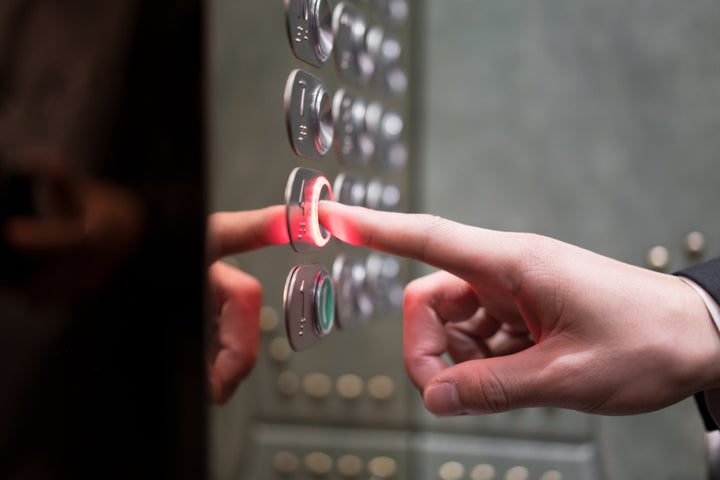
Every Monday, we’ll answer your questions on Covid-19 and health in a feature published online. You can submit a question here.
HuffPost UK reader Jacqueline asked: “How much danger is there for the virus to be passed in an elevator when both riders are masked?”
As society opens up, you might find yourself face-to-face with a stranger in the lift at your local shopping centre – or even at work.
After months of keeping your distance from others, including those you love, it can be pretty jarring to then share a confined space with a stranger – even if it’s for the mere minute-or-so it takes to pass between floors one and five.
So what’s the risk of catching Covid in this instance? Dr Julian Tang, honorary associate professor and clinical virologist at the University of Leicester, says it depends on the lift. For example, some have good ventilation – meaning any problematic particles are dispersed a lot more quickly – while others have none.
If we’re going to talk about risk, we need to discuss the primary ways Covid is spread. Experts now agree the primary route is through respiratory droplets among people who are in close contact. These droplets can be expelled from a person’s nose or mouth when they cough, sneeze, speak, sing or breathe heavily – and can range from larger respiratory droplets to smaller aerosols.
The virus can also spread after infected people sneeze, cough on, or touch surfaces or objects – like a lift button, for example – which others then touch.
Professor Jonathan Reid, director of Bristol Aerosol Research Centre (BARC) and professor of physical chemistry at the University of Bristol, tells HuffPost UK the key factors that would influence whether you caught the virus or not in a lift are “proximity and duration of exposure”.
If the lift is small and social distancing is hard to adhere to, your risk increases because the likelihood of you inhaling dodgy droplets increases – although that’s not to say you’re guaranteed to get sick. We don’t know how much virus a person needs to inhale to become ill with Covid-19. We also know face masks will do a lot of leg work to prevent larger droplets entering your nose and mouth.
“I understand the anxiety is high, but the reality is that the risk in the elevators is quite low.”
- Joe Allen, assistant professor with the Harvard T.H. Chan School of Public Health
Proximity matters because “there is a greater likelihood of transmission both from large droplets and small respirable aerosols if you stand within one-metre of someone, particularly without a face covering,” says Prof Reid.
You might also want to consider the time spent in the lift. A lot of what we know about how Covid spreads is based on people spending longer periods of time together in poorly ventilated spaces. “When using a lift, the risk is probably minimal given the short duration of any exposure,” says Prof Reid.
The other risk would be from touching the buttons, but experts broadly agree that touching infected surfaces isn’t as big a transmission route as we first thought. “If you can’t use a pen or something else you can wash later, you can use hand sanitiser on your finger/hands before and after [touching the buttons],” says Dr Tang. Or if you don’t have any sani on you, don’t touch your face until you can get to a sink and wash your hands.
Ultimately, your risk is pretty low – especially if you take precautions, as Joe Allen, assistant professor with the Harvard T.H. Chan School of Public Health, told ABC 7 News in September: “I understand the anxiety is high, but the reality is that the risk in the elevators is quite low.”
To be extra safe during your time in a lift, Dr Tang recommends wearing a mask, keeping your distance from others and, to be courteous to others, try not to talk – this will reduce the number of droplets expelled from your nose and mouth. And yes, if you’re wearing a mask, these can still escape, especially if your mask isn’t fitted properly around your face.
If at any point you end up sharing the lift with more people and you don’t feel comfortable, wait for the next one or take the stairs.
Experts are still learning about Covid-19. The information in this story is what was known or available at the time of publication, but guidance could change as scientists discover more about the virus. To keep up to date with health advice and cases in your area, visit gov.uk/coronavirus and nhs.uk.